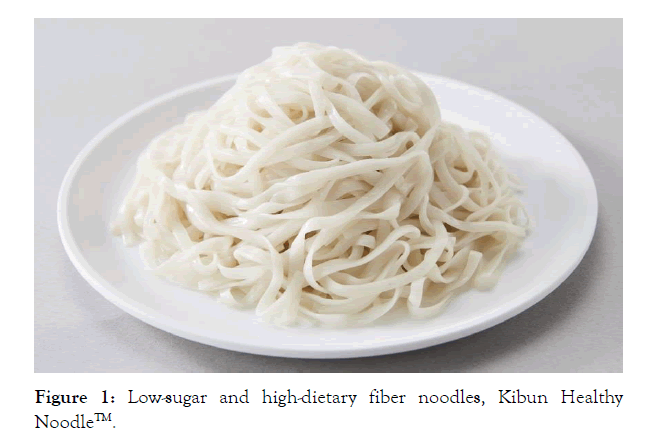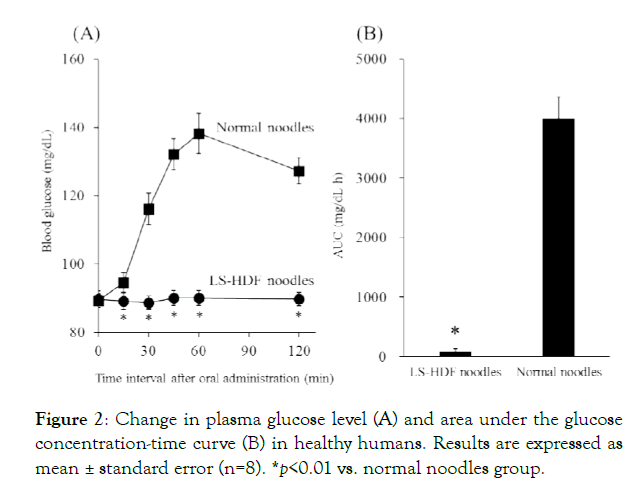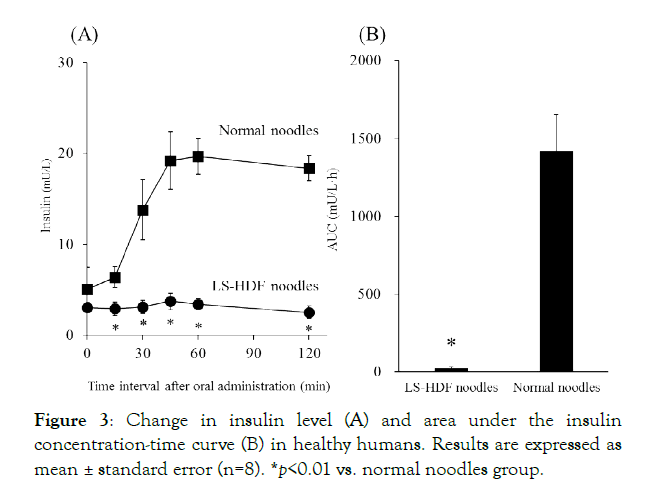Research Article - (2021) Volume 12, Issue 2
Background: Low-carbohydrate diets are popular nutritional therapeutics based on recommendations of the American Diabetes Association (2013). In previous reports, we suggested a new diet-intake restriction method using low-sugar, high-dietary fiber noodles containing okara and konjac and reported their effect on blood glucose levels in healthy animals and animal models of type 2 diabetes. This study aimed to compare the effect of low-sugar, high-dietary fiber noodles with that of normal wheat noodles on glycemic response in healthy adult men.
Methods: The study was a randomized, cross-over design to investigate the effects of normal wheat noodles versus low-sugar, high-dietary fiber noodles on glucose and insulin responses at 120 min. Plasma glucose and insulin levels were measured at 0, 15, 30, 45, 60, and 120 min after intake of normal wheat noodles or low-sugar, high-dietary fiber noodles.
Results: No abnormalities and side effects were observed in the low-sugar, high-dietary fiber noodles group. Additionally,in men who consumed low-sugar, high-dietary fiber noodles, the increase in postprandial blood glucose levels and insulin levels was significantly suppressed compared with that in men who consumed normal wheat noodles.
Conclusion: To the best of our knowledge, this is the first report on the effectiveness of low-sugar, high-dietary fiber noodles on postprandial blood glucose levels in healthy humans; our findings also suggest that such type of noodles might be beneficial for patients with diabetes or celiac disease who consume noodles.
Low-sugar high-dietary fiber noodles diet; Blood glucose; Insulin
The prevalence of type 2 diabetes mellitus is rising globally, and is related to health consequences and healthcare costs [1]. The American Diabetes Association and the British Diabetic Association reported that low-carbohydrate diets (LCDs) may be effectively used as a medical nutritional therapy to manage blood glucose and lipid levels, and that LCDs are effective at lowering blood glucose and hemoglobin A1c (HbA1c) levels [2-4].
Grains such as rice and noodles prepared using rice and wheat are the primary carbohydrate sources for almost all Asian populations [5], and have become a popular food product worldwide [6]. In particular, a vast number of noodles products are made from refined wheat, and the popularity of Asian noodles are increasing around the world [6]. However, high consumption of noodles leads to a higher risk of type 2 diabetes, similar to that observed for high rice consumption [7]. Moreover, oxidative stress and insulin resistance caused by regular remarkable postprandial glycaemia have been identified as important factors contributing to the onset of type 2 diabetes [8]. Therefore, dietary control which shows the suppression of increase in postprandial blood glucose levels is an important strategy against progression of type 2 diabetes [9].
From these backgrounds, we have developed low-sugar, highdietary fiber (LS-HDF) noodles containing a by-product obtained following the processing of soybeans, Glycine max (commonly called “okara”) and Amorphophalluskonjac (commonly called “konjac”) for those who consume noodles regularly. In a previous study, we investigated the effects of LS-HDF noodles intake on blood glucose levels in mouse and rat models for type 2 diabetes [10-12]. However, there are no experimental data on the effects of LS-HDF noodles intake on glycemic response in humans.
In this preliminary study, we have demonstrated the effects of LS-HDF noodles on glycemic response in healthy humans as a crossover trial for the first time.
Materials
Commercial LS-HDF noodles (Healthy NoodlesTM from Kibun Foods Inc., Japan) were used (Figure 1). In brief, okara was mixed with konjac and other ingredients and then boiled. Commercial wheat noodles were used as control noodles. Energy (kcal), proteins (g), fats (g), and carbohydrates (g) of control noodles (180 g) in this study were 209.6, 5.5, 0.7, and 45.3, respectively. By contrast, energy (kcal), proteins (g), fats (g) and carbohydrates (g) of LS-HDF noodles (180 g) were 35.0, 2.4, 1.4, and 11.3 (sugar: 0.0, dietary fiber: 11.3), respectively.

Figure 1: Low-sugar and high-dietary fiber noodles, Kibun Healthy Noodle™.
Study design
Healthy adult men, aged 22 to 35 years, with a body mass index of 18.1 to 23.9 kg/m2, were recruited from the capital area, including Tokyo, Japan (Table 1). The exclusion criteria were (I) any type of physical and mental chronic diseases including type 1 or type 2 diabetes; (II) positive for syphilis, HIV virus, hepatitis B virus, and hepatitis C virus; (III) regular use of supplements/medications that might interfere with the levels of blood glucose and insulin; (IV) allergy to wheat, soybean, and others; and (V) unwillingness to follow the study protocol. The experiments were performed at Kitasato University, Kitasato Institute Hospital. The experimental protocol was approved by the Human Experiment Ethics Committee of the laboratory, and this clinical trial was registered with the UMIN Clinical Trial Registry (no. UMIN000023986). All participants provided written informed consent. Of the twelve eligible men, eight were enrolled in this study.
| Characteristic | Mean ± SE | Values (range) |
| Age (yrs) | 28.13 ± 1.71 | 22 ‒ 35 |
| Weight (kg) | 61.54 ± 2.00 | 52.50 ‒ 70.20 |
| Height (cm) | 172.23 ± 1.35 | 164.30 ‒ 177.10 |
| BMI (kg/m2) | 20.74 ± 0.63 | 18.09 ‒23.89 |
Table 1: Characteristics of healthy adult men (n=8).
The study was a randomized, cross-over design to investigate the effects of normal wheat noodles versus LS-HDF noodles on glucose and insulin responses at 120 min (Table 2). Plasma glucose and insulin levels were measured at 0, 15, 30, 45, 60, and 120 min after intake of normal wheat noodles (180 g) or LS-HDF noodles (180 g). The incremental area under the curve (iAUC) for blood glucose and insulin was assessed between 0-120 min postprandial for all the participants.
| Day | Time | Group I | Group II |
| Day 0 | 3:00 PM | Blood sampling | |
| 6:30 PM | Standardized dinner | ||
| Day 1 | 8:00 AM | Blood sampling | |
| 9:00 AM | LS-HDF noodles | Normal noodles | |
| 9:15 AM | Blood sampling | ||
| 9:30 AM | Blood sampling | ||
| 9:45 AM | Blood sampling | ||
| 10:00 AM | Blood sampling | ||
| 11:00 AM | Blood sampling | ||
| 12:00 PM | Standardized lunch | ||
| 6:30 PM | Standardized dinner | ||
| Day 2 | 8:00 AM | Blood sampling | |
| 9:00 AM | Normal noodles | LS-HDF noodles | |
| 9:15 AM | Blood sampling | ||
| 9:30 AM | Blood sampling | ||
| 9:45 AM | Blood sampling | ||
| 10:00 AM | Blood sampling | ||
| 11:00 AM | Blood sampling | ||
Table 2: Schematic of study protocol.
Statistical analysis
Results are expressed as mean ± standard error (SE). Statistical significance was determined using a paired t-test. A p-value of less than 0.05 was considered statistically significant.
All the participants (8 subjects) who were enrolled in this study completed the study. No abnormalities or side effects were observed in either control noodles or LS-HDF noodles groups.
The results of change in plasma glucose level are shown in Figure 2. The postprandial blood glucose levels of the control noodles group increased with time and showed a marked rise at 30 min after administration. However, the blood glucose levels of the LS-HDF noodles group remained stable for 120 min (Figure 2). The LS-HDF noodles group showed an approximately 98 % reduction in glucose iAUC values compared to the control noodles group (Figure 2).

Figure 2: Change in plasma glucose level (A) and area under the glucose concentration-time curve (B) in healthy humans. Results are expressed as mean ± standard error (n=8). *p<0.01 vs. normal noodles group.
The results of change in insulin level are shown in Figure 3. In the group that consumed LS-HDF noodles, the increase in insulin level was significantly suppressed at 120 min after administration than in the control noodles group (Figure 3). The LS-HDF noodles group exhibited an approximately 99% reduction in the insulin iAUC values compared to the control noodles group (Figure 3).

Figure 3: Change in insulin level (A) and area under the insulin concentration-time curve (B) in healthy humans. Results are expressed as mean ± standard error (n=8). *p<0.01 vs. normal noodles group.
Type 2 diabetes mellitus is a chronic metabolic disorder. The morbidity of the world population attributable to diabetes is expected to increase from 415 million in 2015 to 642 million by 2040 [13]. The number of people with diabetes is increasing due to population growth, aging, urbanization, obesity, and physical inactivity [1], and refined carbohydrates, including rice and noodles have been implicated in the deterioration of glucose metabolism [14]. However, rice and noodles are major staple foods of Asian people such as the Chinese, Korean, and Japanese. Therefore, we have developed LS-HDF noodles containing okara and konjac for those who consume noodles regularly. In this study, we demonstrated the effect of LS-HDF noodles on glycemic response in healthy humans as a cross-over trial for the first time.
In a previous study, we investigated the effect of LS-HDF noodles intake on blood glucose levels in healthy ICR mice compared with that of commercial wheat noodles intake and reported that the increase in postprandial blood glucose levels was significantly suppressed after consumption of LS-HDF noodles [10]. In this study, postprandial blood glucose levels of the LS-HDF noodles group remained stable for 120 min after consumption of LS-HDF noodles. This result was almost similar to that of our previous data on mice; however, the difference in postprandial blood glucose levels between healthy humans who consumed wheat noodles and LS-HDF noodles was increased compared with that of healthy mice. The postprandial blood insulin levels of the LS-HDF noodles group remained stable for 120 min after intake of LS-HDF noodles. Accili et al. reported that not only hypoinsulinemia, but also hyperinsulinemia was harmful for body functions [15]. In particular, high levels of insulin levels in otherwise metabolically healthy persons are assumed to pose a risk factor towards the development of obesity [16, 17]. To prevent obesity in healthy individuals, it is important to suppress the increase in insulin levels. Therefore, we thought that LS-HDF noodles might be effective to prevent obesity. In addition, it is crucial to prevent metabolic syndrome diseases such as hyperglycemia and hyperlipidemia [18]. To reduce the number of individuals suffering from such diseases, it is necessary to develop processed foods that do not stimulate an increase in postprandial blood glucose levels and secretion of insulin [19]. Taking these reports into account, it can be suggested that LCDs such as LS-HDF noodles might be effective in protecting against metabolic syndrome diseases.
In the present study, we investigated the effect of LS-HDF noodles on glycemic response in healthy humans using a single meal test. In a previous study, we had demonstrated the effect of LS-HDF noodles on blood glucose levels in Spontaneously Diabetic Torii fatty rats for a model of obese type 2 diabetes (28 days administration). In the study, we reported that the levels of blood glucose, HbA1c, and glycated albumin levels of the LS-HDF noodles group were significantly lower than those of control group [12]. Moreover, an oral glucose tolerance test (OGTT) after administration of LS-HDF noodles for 28 days indicated that blood glucose levels of the LS-HDF noodles group were significantly lower than those of control group [12]. From this result, we could predict that intake of LS-HDF noodles might be effective for preventing type 2 diabetes in humans.There are benefits and risks of an LCD in type 2 diabetes patients; LCD increases mineral deficiency and hypovitaminosis and reduces dietary fiber intake [20,21]. The dietary fiber levels were 11.3 g in the LS-HDF noodles used in this study (180 g). This indicates that LS-HDF noodles can replenish dietary fiber in LCDs, and LS-HDF noodles showed antioxidant activity in vitro [12]. Soy residues “okara” which contained a by-product obtained following the processing of soybeans is one of main ingredients in LS-HDF noodles. Okara is only soy residue, even though, it is rich in nutrients. In generally known, okara dry matter contains the insoluble fiber [22], protein [23], lipid [24] and isoflavones [25]. Especially, approximately 40-60 % insoluble fiber (cellulose and hemicellulose) is contained in dried okara. Moreover, Vital et al. reported that phenolic compounds and flavonoids which showed antioxidant activities was contained in okara [26]. Furthermore, in our previous reports, we investigated that okara and fermented okara with Rhizopusoligosporus showed the reactive oxygen scavenging activity [27-28]. Konjacis one of main ingredients in LS-HDF noodles as well as okara. Konjac contained the konjacglucomannan, is water soluble polysaccharide [29]. Zhao et al. carried out the in vivo antioxidant and anti-inflammatory effects of konjacglucomannan in type 2 diabetic rats [30]. Therefore, we expect that the LS-HDF noodles which have the antioxidant activities might be effective for protecting against type 2 diabetes mellitus.
In conclusion, globally, many people as well as patients with type 2 diabetes consume seasoned staple foods containing rice, bread, and noodles that are rich in carbohydrates; consequently, it may be difficult to follow an LCD in daily life for long periods. There are numerous methods for the management of type 2 diabetes, and one of the effective methods is dietary carbohydrate restriction such as following an LCD. Although an LCD has both benefits and risks, it is important to individualize the diet consumed. In this preliminary study, we have described the effects of LS-HDF noodles in healthy humans using a single meal test and presented new information on simple methods for the management of diabetes.
We are grateful to Masahito Hoashi, Chairperson and C.E.O. of Kibun Foods Inc., for supporting this study. An earlier version of this work has been presented as a preprint: https://www.researchsquare.com/article/rs-111425/v1.
No funding.
The authors declare that there are no conflicts of interest.
The experiments were performed at Kitasato University, Kitasato Institute Hospital. The experimental protocol was approved by the Human Experiment Ethics Committee of the laboratory, and this clinical trial was registered with the UMIN Clinical Trial Registry (no. UMIN000023986). All participants provided written informed consent.
Citation: Kadokura K, Tomita T, Hata S, Kamata K, Suruga K (2021) Effect of Low-Sugar and High-Dietary Fiber Noodles on Glycemic Response in Healthy Humans: A Cross-Over Trial. J Diabetes Metab 12:862.
Received: 17-Feb-2021 Published: 15-Mar-2021, DOI: 10.35248/2155-6156.21.12.862
Copyright: © 2021 Kadokura K, et al. This is an open-access article distributed under the terms of the Creative Commons Attribution License, which permits unrestricted use, distribution, and reproduction in any medium, provided the original author and source are credited.